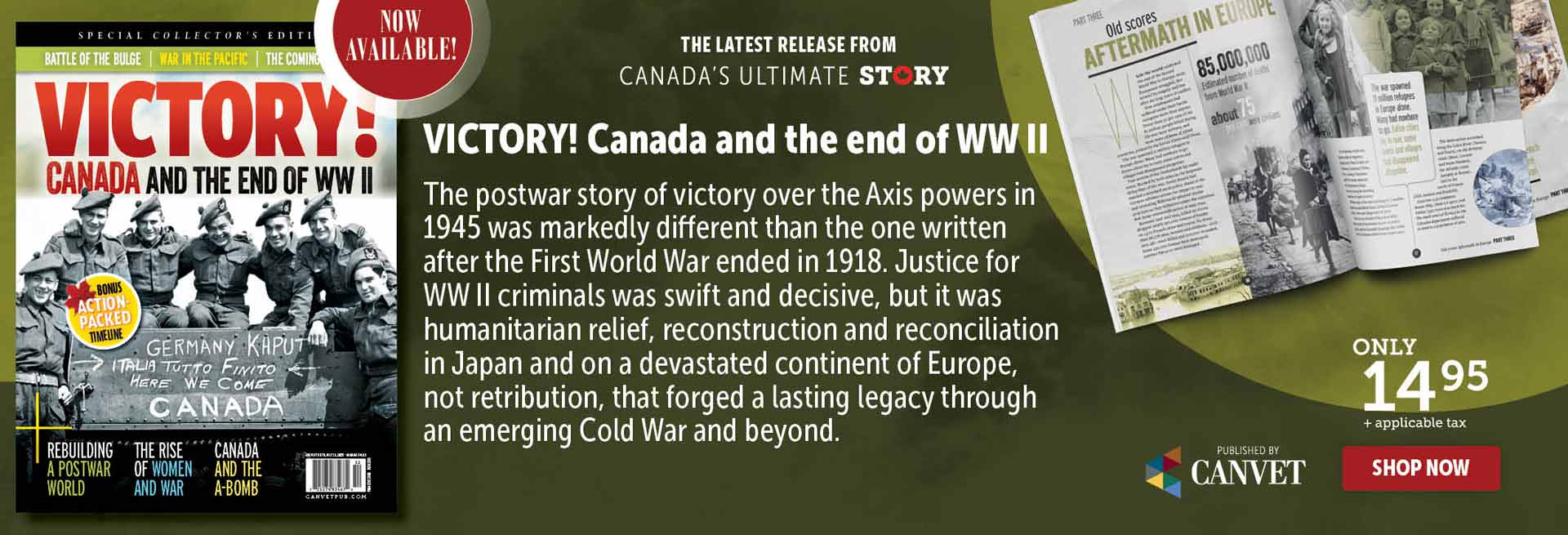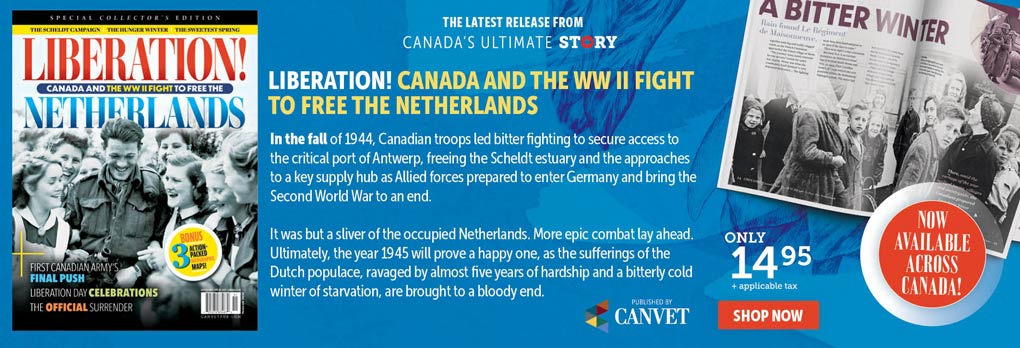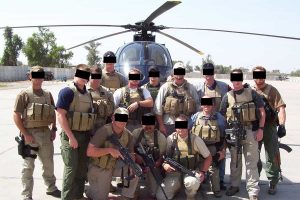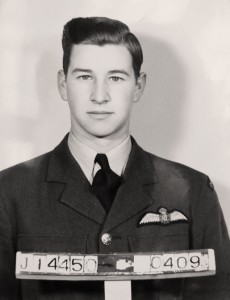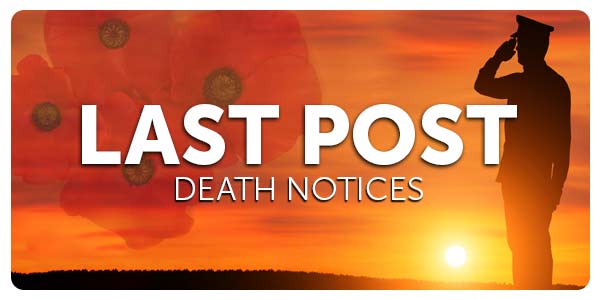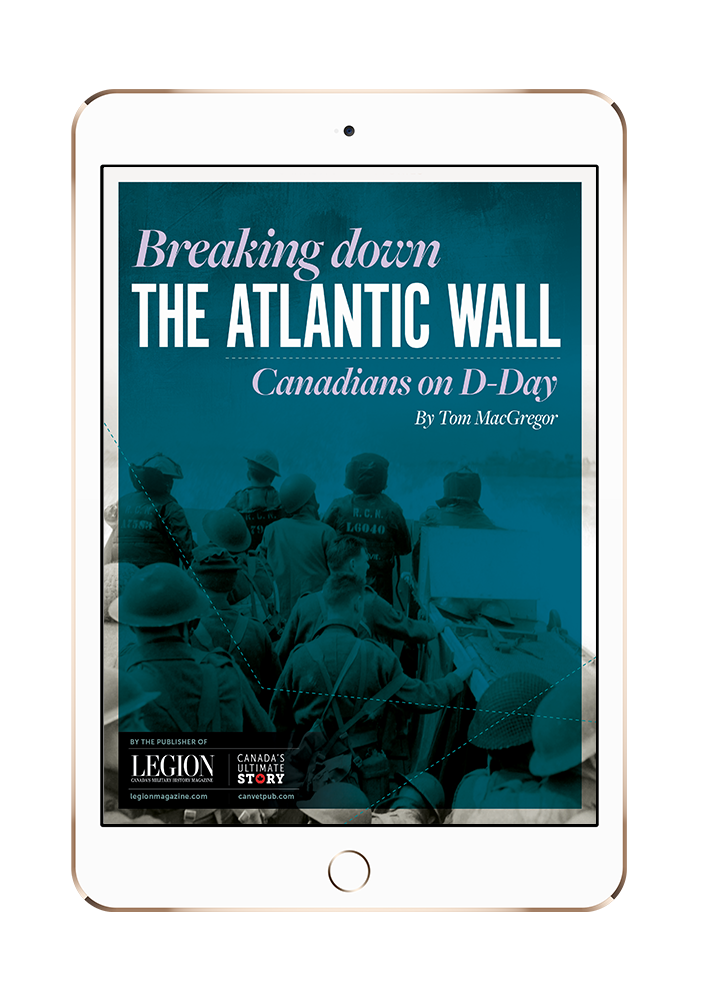
Dutch children eat their daily ration of food during the 1944-45 Hunger Winter.[Menno Huizinga/NIDO Institute for War, Holocaust and Genocide Studies/Wikimedia]
By the time First Troop, Charlie Squadron, of The Royal Canadian Dragoons reached the northern Netherlands in late April 1945, the Second World War was into its final days, and the Netherlands had been under savage Nazi occupation for five years.
In cities such as The Hague and Amsterdam, where the Germans had set up blockades to prevent the arrival of food, an average of 300 Dutch citizens a day were dying of starvation.
On farms, both in the Netherlands and across the border in Germany, Dutch captives, some of them adolescents, were performing slave labour to produce food for the German military—and were barely fed themselves.
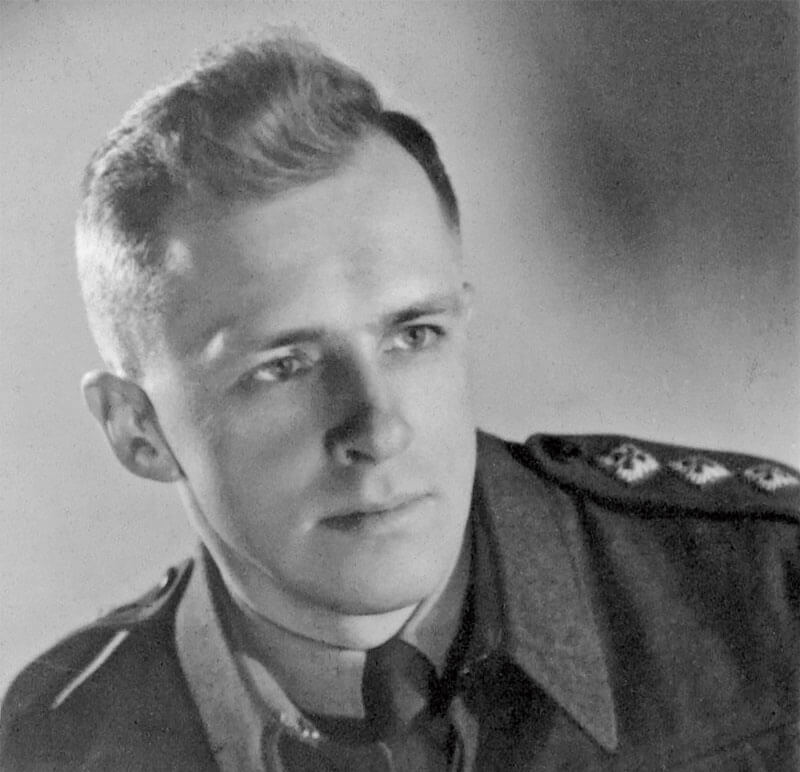
Lieutenant Charles (Charlie) Hume Wilkins, pictured in 1943, was among Canadian soldiers who helped liberate the Netherlands [Courtesy Charles Wilkins]
In German factories, Dutch and eastern European prisoners, invariably under armed guard and sometimes shackled to the machinery, produced battle gear and munitions for the German fighting forces.
My dad, Lieutenant Charles Hume Wilkins—Charlie, to the men in his platoon—was part of First Troop, Charlie Squadron, and the diary he kept as the Canadians rolled deep into northern Holland paints a rousing and memorable picture not just of the horrors experienced by the Dutch under Nazi occupation, but of the sheer joy, the wild sense of celebration that exploded among the Dutch citizens as the Canadians appeared, sweeping the last of the occupying Nazis either back across the border into Germany or into prisoners’ cages, where the captured German soldiers got a taste of the treatment they themselves had been dishing out.
“And, indeed, they had been dishing it out,” wrote my dad in a late-April diary entry that goes on to describe a reconnaissance mission he led into the west German borderlands near the village of Friesoythe. In their armoured cars, the Canadians came across a rundown concentration camp, where the Nazis had locked Polish and eastern European prisoners in crowded cages and left them more or less to starve.
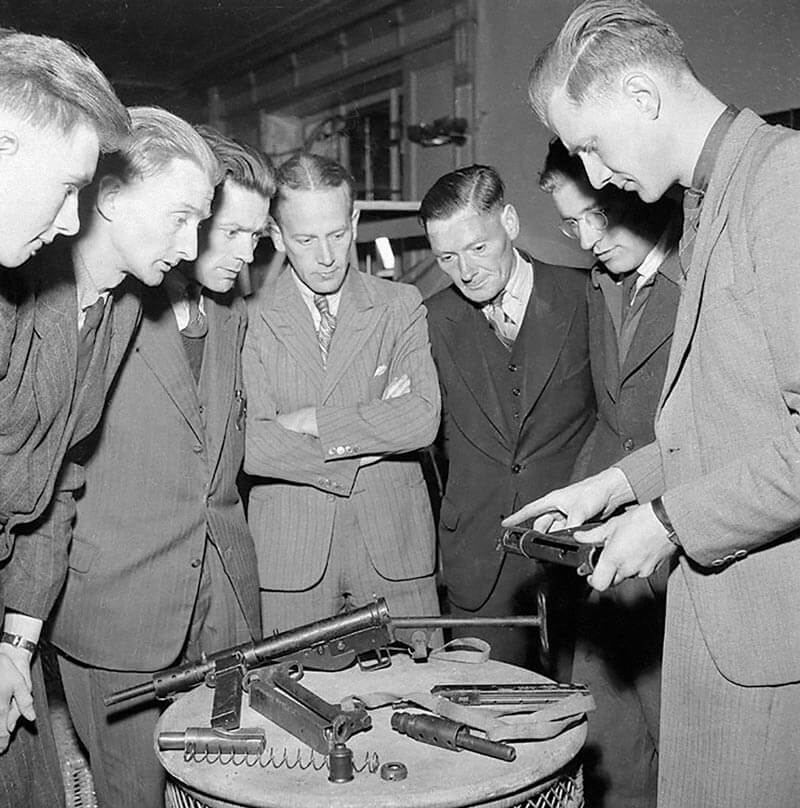
Members of a Dutch resistance group receive weapons training in Amsterdam in April 1945. [Cas Oorthuys/NFA, collectie Nederlands fotomuseum]
“Mere bags of skin and bone,” my dad called the prisoners, noting that “the newspaper stories of atrocities were coming true before our eyes—but they were still hard to believe.”
With the arrival of the Canadians, northern Dutch towns such as Steenwijk and Franeker were freed not just of uniformed German soldiers, but of the presence of the reviled Gestapo, the Nazis’ plain-clothed secret police. In Steenwijk, members of my dad’s platoon captured a Gestapo agent who had been responsible for the deaths of several local boys and locked him in a truck, barely able to prevent the townsfolk from tearing the truck apart in their ambition to tear up the agent himself.
As celebrations welcoming the Canadians rocked the thousand-year-old city of Leeuwarden in the north, a young man named Freddy Ringnalda invited my dad to dinner at his parents’ home. While the family and their Canadian guest ate a sumptuous celebratory meal, Fred explained to my dad that six months earlier he had escaped Gestapo agents who had come to the factory where he worked, intending to arrest him and put him to slave labour in a nearby German munitions factory.
Fred had escaped the secret police by the narrowest of margins when a factory foreman caught wind of the Gestapo’s approach and, as they were entering the factory by the front doors, ordered Freddy to lie down on a wheeled dolly, covered him with a tarp, and spirited him by elevator into the basement and out a shipping door at the back of the building.
Not that Freddy’s escape brought any sort of real freedom; he was obliged, rather, to spend the remainder of the war hiding in a musty and lightless attic under the eaves of his parents’ home.
Some of the diary’s tales describe events so theatrical and satisfying and, for my dad at least, so personal that their outcomes and the people involved would affect his life for decades to come.
Near Heerenveen, for example, a battle-weary Dutch Resistance fighter, “just a kid but a strong one,” named Pete Toxapeus approached Charlie Squadron, offering much-welcomed services as a translator and navigator, and proceeded to facilitate the Canadians’ journey on a landscape where they knew neither the language nor the geography nor the social customs.
So appreciative was my dad of Pete, and vice versa, the two remained friends long after the war. Indeed, during the 1950s, Pete crossed the Atlantic by ocean liner for the sole purpose of reuniting with and, in effect, thanking my dad.
However, in those last brutal days of the war, travelling with the Dragoons, the young resistance fighter was a kid known less for amicability than for toughness and fearlessness—and for a trait not always noted, much less emphasized, in more formal or discreet histories of the war: that of a low-key desire for vengeance, at an all but personal level.
Pete’s aptitude for payback was triggered not just by the plight of his own people, but by the mistreated or enslaved citizens of half a dozen other countries occupied and brutalized by the Nazis. On a mop-up excursion across the border in Germany, for example, Pete and the Canadians learned of a German farmer who had been ruthless in his treatment of several Czech and Polish prisoners, including an 11-year-old Polish boy. On April 28, 1945, my dad recorded that “Pete paid an early morning visit to the erring farmer, and put him into a state of fright that he will remember as long as he remembers anything.”
Given the oppression suffered by the Dutch, it’s no wonder that when their Canadian liberators got to, say, Leeuwarden, a city of more than 100,000 people, the Canadians were surrounded by screaming children and teenagers throwing bouquets of tulips; and by young women who, clad in their spring dresses, hair flying, took the non-plussed Canadians in their arms, encouraging them to dance, to feast, to party in streets packed, day and night, with celebrating Netherlanders.
“At about noon the day after our arrival in Leeuwarden,” wrote my dad, “we rode away towards the east, and in a couple of hours reached a tiny village called Oldekerk. Here, too, there was a fiesta going on in honour of the liberation, and all afternoon and evening the grassy field where we harboured was full of admiring men and women. As in Leeuwarden, the girls here were lovely; half the men in the troop fell in love with somebody before the day was out.”
While the romance, as presented by the diary, is both sweeping and dream-like, it’s also humanized and anchored by the most meticulous and homey of details. “Towards supper-time,” wrote my dad, “I brought out a round of Dutch cheese that Fred Ringnalda had given me as a parting gift, and proceeded to cut a good-sized wedge out of it in the well-known Canadian manner. There were half a dozen girls crowding our picnic site and they all burst out laughing, took the cheese away from me and showed me how to shave a piece off, very thin, as the Dutch do.
“I couldn’t help admitting that they were right—the shavings seemed to have a more delicate flavour than a bigger piece.”
The diary describes the Dutch celebrants as “all but maniacal in their desire for whatever tobacco the Canadians had to share,” and notes the capability of the young men and women to roll “an Oldekerk slim,” a cigarette “barely thicker than a toothpick,” but nonetheless significant to the village’s robust celebrations.
“Meanwhile, out on the road,” the diary continues, “the celebrating Dutchmen crowded around the armoured cars and climbed onto the sides, pleading for cigarettes—to the point where it was almost disastrous to give one away, in that the gift brought twenty more men clutching for the coveted tobacco.”
As the narrator of all this drama and history—and, in a sense, curator of the diary—I must pause for a moment to say that the reason for publishing the story now, during the spring of 2025, is that exactly 80 years have passed since the Dragoons, among other Canadians, rolled into the Netherlands; since my dad sat by Dutch roadsides and barns, or in the safety of his armoured car to pen the extraordinary diary that brings to life that final Canadian mission of the Second World War.
One of the diary’s most adamant and prevalent motifs, I must emphasize, was that the march into the Netherlands was a story not just of triumph and romance, but of caution and suspicion and fear. Pockets of Nazi soldiers still hid in the villages, or along the roads, determined to inflict a last crack of the whip on the allied enemies of the Reich.
In one village, the Germans piled tree trunks across the road. When my dad got out to begin clearing them, the road exploded within metres of him, and the air was full of lead. “I was lucky to escape back into the armoured car,” he wrote, “by pounding on the side door until my gunner, Braden, opened it and I dove inside.”
On the same day, the Canadians came to a gathering of Dutch women and children parading beneath a Red Cross banner strung across the road. “We sent a scout forward, who came running back, head down, with word that behind every tree up ahead, a Jerry infantryman was waiting with a faustpatrone [a hand-held anti-armour weapon, capable of piercing an armoured car]. The Dutch villagers had been forced to parade beneath the Red Cross sign as a means of dissuading the Canadians from firing as we approached.”
At the town of Holten, due east of Amsterdam, Charlie Squadron encountered what the diary describes as “a pocket of fierce loyalists to the Reich,” eventually forcing them to raise the white flag of surrender on the village church tower.
“When our infantry brought back prisoners, we were surprised to discover they were just teenagers, paratroopers, who had fought like madmen, holding up the Canadian armoured car advance with dogged courage; one soldier cannot help admiring another, and I could hardly do less than admire such determination.”
It is not your average soldier who writes so appreciatively of the courage and persistence of his opponent. My dad, I hasten to add, was not an average soldier (one could ask, what soldier is?).
Back home in Canada, he was a poet, an opera-lover, a birdwatcher. He loved books (by the time he was 16, he had read every one of the approximately 300 novels in the Hespeler, Ont., library). A descendant of peace-loving Quakers, he wasn’t only non-violent, but almost pathologically non-competitive.
When I was a boy, I remember him speaking with pride about having participated in the mile-run at a high school track meet and having been happy to finish last. At board games, he deliberately let others win.
Where real battle was concerned, however, he had a knack, had what U.S. astronauts would eventually call “the Right Stuff.” He had taken a demotion from captain to lieutenant so that he could get overseas and fight. During the Italian Campaign, he was Mentioned in Dispatches for what was termed his “exceptional bravery in battle.”
At the same time, he harboured a vulnerability and wasn’t afraid to say so. One afternoon in the central Netherlands, a German munitions truck blew up within steps of his platoon’s position, sending shrapnel and flame 40 metres in all directions. “As I stood in the turret of my Stag trying to regain my composure,” he wrote in his diary that night, “I lapsed suddenly into a kind of shivering fit—it seemed to me that all my nervous fiber had come unstrung, and that I was standing there, surviving, by will-power alone.”
The only thing I ever heard him say in the way of self-credit, if not exactly self-praise, was that in his role as a lieutenant, platoon leader and reconnaissance man, he never asked one of his men to do anything that he wasn’t willing to do himself. And he backed it up. Years later, my dad’s gunner, Jim Braden, who was visiting our home in Deep River, Ont., reported to me that my dad had one night belly-wriggled across a field, under heavy German fire, to fix a communications wire, while his platoon watched from safety.
Understandably, he was popular with his men.
Meanwhile, I have sometimes wondered what motivated him to keep such a detailed diary, when for most soldiers just staying alive and sane was a sufficient challenge during the five-year nightmare that was World War II.
The short answer, I have come to believe, is rooted in childhood trauma, specifically in the simple but devastating fact that his mother died the day he was born in 1912. As a boy, lacking the nurturing he would have received from his mother, he found comfort and emotional structure in stories, in reading and, eventually, in storytelling and writing.
In the same sense that literature brought a kind of order and sustenance, as well as humour, to his isolated existence as a child, his compulsion to keep a diary about his life in the trenches and on reconnaissance—to convert it into written stories—became a kind of ordering and managerial principle for the chaos and suffering that surrounded him during the war. I suspect, too, it helped dispel what my dad once described as “the sense of futility, sometimes meaninglessness, that at one time or another haunts every soldier who ever took a bullet or piece of shrapnel, or fired at an enemy or went into battle, period.”
For most of my life, I didn’t even know the diary existed. And my dad (who during the years after the war despaired of his battle experience sometimes to the point of considering suicide) said almost nothing about what he had encountered in Italy or the Netherlands.
Then, out of the blue, a Dutch scholar named Edwin Meinsma contacted me in late 2022 with word that he was writing a book about the Canadians’ role in liberating his home territory of Friesland in the northern Netherlands. He had obtained a diary, I believe from the Canadian War Museum, in which the writer, a Lieutenant C.H. Wilkins, recorded his experiences in helping rid the Netherlands of Nazis in 1945.
Edwin wanted to quote the diaries in a book he was writing about the role of The Royal Canadian Dragoons in the liberation. He had seen the name Wilkins in battle reports, had discovered, using the internet, my own existence as a writer, and was contacting me, wondering if the two Wilkinses were related. More importantly, he sent me the diaries.
It was a Hamilton psychiatrist who first suggested to me that, in writing the story, my dad had created a kind of cartography for the psyche and memory, a way of interpreting the madness and hence locating a measure of understanding, even solace, where otherwise none would have existed.
The diaries also provide, of course, a wealth of insights and perspective on the broader backdrop to war: on how a soldier sees his enemy, how he views the landscape on which the battles are fought; understands fear, camaraderie, leadership; sees what it is to be but the smallest of parts in a vast, all but inanimate army on the march in a war that perhaps not even the generals entirely understand.
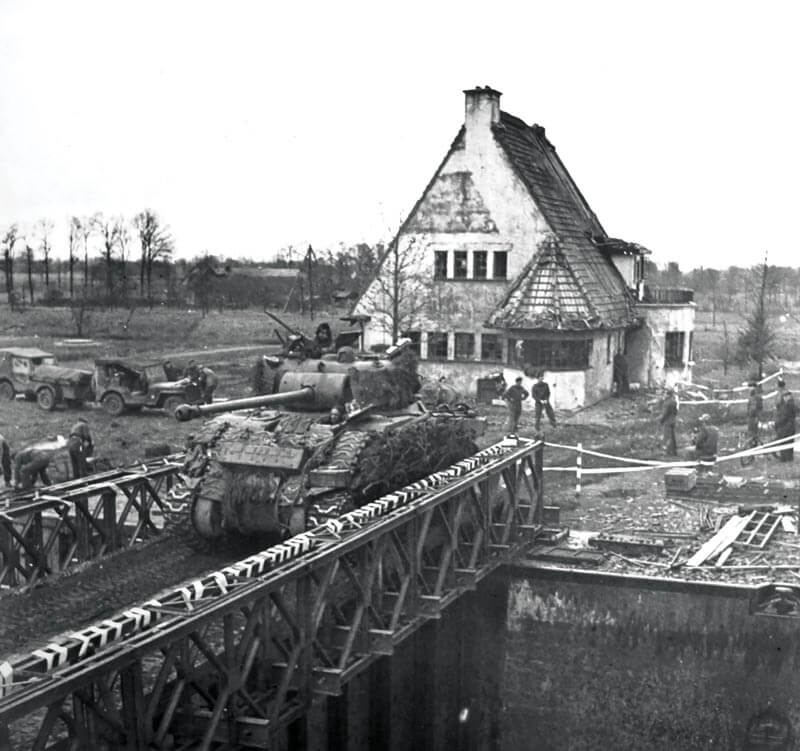
Tanks cross a Bailey bridge at the Netherlands’ Twenthe Canal on April 4, 1945. [Alexander M. Stirton/DND/LAC/PA-130910]
As the impatient Charlie Squadron awaited orders for its advance into the Netherlands, my dad wrote: “It is not given to the submerged ninety-nine percent of the army to plan its own future or to know what is planned for it. Meanwhile, a rumour is the breath of life to a soldier. It need not be true; the more preposterous the more readily we accept it. But we are pessimists; the belief prevails that the army, that huge, intangible, and all-powerful elephant will fool you if it can.
“Meanwhile, our wait was livid with rumours: we were headed north; were headed east into Germany; were to be replaced by another detachment; were waiting for reinforcements. The rumours followed one another, tripped over themselves, cancelled each other out; they grew and expanded, and were in the end swallowed up by bigger rumours.”
One of the beauties of the diary is that, against the enormity of the war, it regularly homes in on the smallest and most human of details. Near Okkenbroek, in the central Netherlands, for example, it reports that “the mail came up that night, including a book of cartoons clipped from the New Yorker magazine and sent to me by my cousin. There is something exhilarating, something happily absurd, about reading a joke book as you shelter from enemy fire in a trench on the front line.”
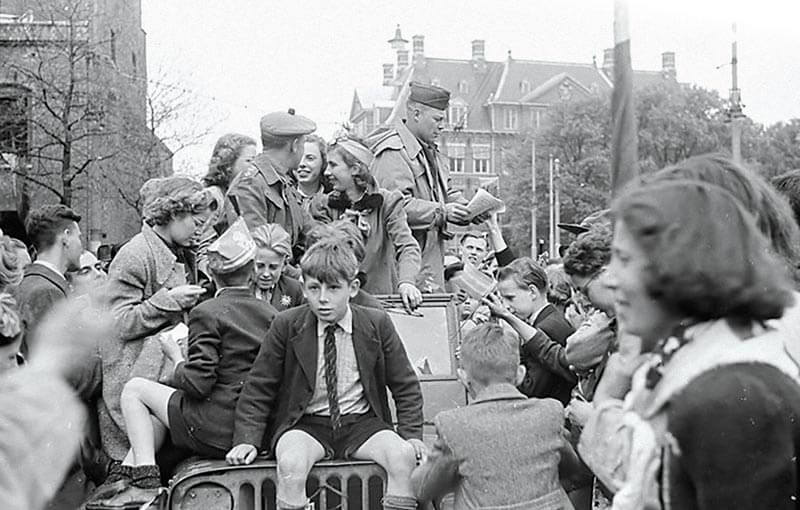
German and Hungarian prisoners ride a Staghound armoured car near Sögel, Germany, on April 10, 1945. [Menno Huizing/NFA, collectie Nederlands fotomuseum]
As First Troop prepared to enter Steenwijk to rout out a handful of Nazi snipers, the diary reports that “in preparation, we checked our maps, fueled up the Stag, and had a quick brew-up.” Of tea.
As for the big picture, the diary is most decidedly about the liberation of the Dutch people, the grand celebration and, by extension, the loving and supportive relations that to this day bind Canada and the Netherlands. At the same time, in the depths of its revelations, it’s about something darker, something more telling: which is to say, the incomprehensible force that had ensnared the two countries in the war in the first place.
We are talking, of course, about the Nazis, the German military—or, more accurately, the ghost of the German military, which in the spring of 1945, as the Canadians moved north toward Heerenveen and Leeuwarden, still haunted and obsessed both the Dutch citizens and their Canadian liberators.
In the Dutch village of Wolvega, my dad conversed amicably with a man he described as “elderly, gentle, soft-spoken…. However, when I asked him what the Dutch had found to say to the Germans when they met them, his face stiffened, and he replied coldly, ‘We did not see them!’”
For my dad, even a German corpse possessed a kind of bedevilment and mystery: “I never quite lost the morbid interest I had in seeing their quiet bodies. A live German, too, had a little of the fascination of a wild animal; it is not easy to think of your dreadful hidden enemy as a man like yourself.”
In describing a mop-up foray into the German villages across the border from the Netherlands, the diary notes, “there was something eerie about this stricken land, something one could feel, a sense of mysteries suddenly explained, or of a shocking exposure of hell on earth. It was different from anything I had ever felt in Italy, where the German had been out of his element.
“Here, we were on his home ground and could look into his shattered windows, pass by his aspiring Gothic churches, see the colour of the flowers in his gardens, know something about his life at home. It was a deeply unsettling experience; there were no friends for us, as there had been among the Italians; here every hand was against us; none was to be trusted.”
As the war entered its final days, the diary turned away from the Germans and, again, toward the long-suffering Dutch who could not do enough to support the work of the arriving Canadians. At the town of Dieverbrug, where a key bridge had been blown up by the retreating Nazis, half the able-bodied men in the community turned out and created a kind of causeway of boats across the canal, and laid loosely bolted planks across their decks, sufficient to support First Troop’s 12-tonne Staghounds.
“Lieutenant Dick Rigby warned all the crews to open their car doors before crossing in case a car should break through and the occupants have to escape under water.
However, all the cars made it, and in the villages to the north, the Dutch clambered onto every vantage point from which they could see us and holler their welcome. There were flags on the lamp posts and buildings, and orange banners representing the ancient House of Orange, all of it more like a carnival than a war.”
Upon re-entry into Leeuwarden, First Troop was met by an “almost hysterical patrol” of Dutch Resistance men. “Near the main square, Major Veitch ordered us to wait until the Colonel could come up and officially enter the city. From his position above the fray, he didn’t know of course that stopping was a hazard; immediately, we were overwhelmed by a crush of people—hundreds of them, hollering and banging on our cars. From the open turret, I watched a boy tear down a German signpost and throw it in the river, while the crowd screamed.”
Late in the afternoon, Charlie Squadron retired to an outlying village, where they received orders to chase a straggle of Nazis from a nearby woods.
“We were just about to start our cars when an order came countermanding the first order, and instead we advanced to Harlingen, then Franeker where, because we could not stay the night and thereby could not guarantee the town’s safety, the Resistance would not allow Dutch flags to be flown. But the crowd was wild.
“In the town square, where we stopped, several thousand people gathered around us and spontaneously raised their voices in the Dutch National Anthem. There was something soulful and hair-raising about it all; and for the first time in five years, the enemy could do nothing to prevent it. For me it was one of the most moving experiences not just of the war but of my life to that date.”
On May 4, a rumour reached Charlie Squadron that the war was about to end. “The next morning,” reported my dad, “we got the signals sergeant to hook up a radio set, and as we sat and listened, the blessed words came over the air that Montgomery had received the surrender of all enemy troops in northwest Germany and the surrounding regions. It was like eating apple pie with whipped cream—too good to be true. Nobody could quite fathom it.”
For the next few days, Charlie Squadron gathered up prisoners in half a dozen towns just across the Dutch border in Germany. They held their victory party in the railway station in Ihrhove, with what the diary discreetly calls “all necessary adjuncts to celebration.”
On May 8, still in Germany, my dad and his platoon listened to the speeches made in London in celebration of VE-Day. “The King, Mr. Churchill, and numbers of others added their voices to the mountain of tributes paid to the troops who had done the fighting. But these sentiments seemed strangely remote and inconsequential to us; I suppose they sounded better to our families at home.
“Soldiers are hard to impress; they develop a kind of shell around their emotions, that no amount of public speaking, however sincere, can penetrate.”
A few days later, Charlie Squadron moved south through Papenburg and Westerbork to a tiny rural Dutch village—“among the cows and trees and little red brick houses,” as my dad described it, “We were on Allied soil again, and had done our jobs, both for the world and for the Dutch. And of course for ourselves.
“It occurred to me, and has occurred to me since, that we perhaps did our job for the Germans as well. We dared to believe the future would be better for them too. Whatever the case, the war was over. Our guns sat empty. Orders had ceased.”
First Troop, Charlie Squadron, Royal Canadian Dragoons, was going home.

Locals crowd around Canadian soldiers in The Hague on May 6, 1945. [Alexander M. Stirton/DND/LAC/PA-159169]
Advertisement





